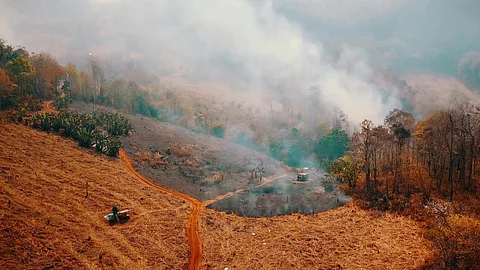

The Earth has entered a “critical and unpredictable new phase of the climate crisis,” with 25 out of 35 planetary vital signs reaching extreme levels, warned a new climate report published in the journal Bioscience.
Some of these planetary vital signs include human population growth, ruminant livestock numbers, per capita meat production, global gross domestic product (GDP) and coal and oil consumption.
Human and livestock populations have been rising at alarming rates, increasing by approximately 200,000 and 170,000 per day, respectively, noted the paper, The 2024 state of the climate report: Perilous times on planet Earth. Fossil fuel consumption has also surged, with coal and oil use increasing by 1.5 per cent in 2023.
Although renewable energy witnessed some growth during the year, fossil fuel consumption remains approximately 14 times higher than that of solar and wind energy. Global tree cover loss also escalated, rising from 22.8 mega hectares (Mha) annually in 2022 to 28.3 Mha in 2023, marking the third-highest rate on record. Wildfires alone caused a record loss of 11.9 Mha of tree cover.
“High rates of tree cover loss can drive a set of related feedback loops, wherein the loss of forest carbon sequestration leads to additional warming, which can drive further losses in carbon sequestration and so on,” the researchers wrote in the study.
Greenhouse gas emissions have also reached record levels, with carbon dioxide, methane and nitrous oxide concentrations becoming critically high. The top three emitters are China, the United States and India, while the highest per capita emissions are seen in the United Arab Emirates, Saudi Arabia and Australia.
Global surface temperatures are at an all-time high, with scientists predicting that 2024 may be one of the hottest years ever recorded. Ocean heat content and acidity have both reached unprecedented extremes, contributing to mass mortality events among marine animals, particularly during the heatwaves of 2021 and 2023.
Furthermore, between November 2023 and August 2024, the world experienced 16 climate disasters. The report also highlights that ice mass in Greenland and Antarctica, along with average glacier thickness, has dropped to record-low levels.
The report also raised concerns about the changing hydrology and water biogeochemistry of Arctic watersheds due to climate change. It notes that Arctic streams have turned orange because of increased iron and toxic metal levels, a process that began in the last decade and is linked to global warming and permafrost thaw.
This discolouration correlates with declines in the diversity of macroinvertebrates (animals without a backbone visible to the naked eye) and a reduction in fish populations, impacting drinking water and subsistence fishing in rural Alaska.
“A large portion of the very fabric of life on our planet is imperilled,” William Ripple, distinguished professor at the Oregon State University College of Forestry and one of the authors of the report said in a press statement.
We are already in the midst of abrupt climate upheaval, which jeopardises life on Earth like nothing humans have ever seen. Ecological overshoot, taking more than the Earth can safely give, has pushed the planet into climatic conditions more threatening than anything witnessed even by our prehistoric relatives
William Ripple, study author
The report also pointed to the growing focus on research into solar radiation modification (SRM), also known as solar geoengineering, which aims to reflect sunlight away from the Earth to mitigate climate change.
Critics argue that SRM is a misguided approach that could disrupt weather patterns and detract from emissions reduction efforts. However, research continues to assess its feasibility and risks. The report stressed the importance of studying the potential environmental, social and geopolitical impacts, alongside evaluating its effectiveness and safety on both regional and global scales.